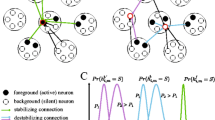Abstract
An autoassociative memory network is constructed by storing reference pattern vectors whose components consist of a small positive number ∈ and 1-∈. Although its connection weights can not be determined only by this storing condition, it is proved that the output function of the network becomes a contraction mapping in a region around each stored pattern if ∈ is sufficiently small. This implies that the region is a domain of attraction in the network. The shape of the region is clarified in our analysis. Domains of attraction larger than this region are also found. Any noisy pattern vector in such domains, which may have real valued components, can be recognized as one of the stored patterns. We propose a method for determining connection weights of the network, which uses the shape of the domains of attraction. The model obtained by this method has symmetric connection weights and is successfully applied to character pattern recognition.
Similar content being viewed by others
References
Amari, S., “Characteristics of Sparsely Encoded Associative Memory,”Neural Networks, 2, pp. 451–457, 1989.
Amari, S. and Maginu, K., “Statistical Neurodynamics of Associative Memory,”Neural Networks, 1, pp. 63–73, 1988.
Atiya, A. and Abu-Mostafa, Y. S., “Analog Feedback Associative Memory,”IEEE Transactions on Neural Networks, 4, pp. 117–126, 1993.
Cottrell, M., “Stability and Attractivity in Associative Memory Networds,”Biological Cybernetics, 58, pp. 129–139, 1988.
Kohonen, T.,Self-Organization and Associative Memory, Springer-Verlag, New York, 1984.
McEliece, R. J., Posner, E. C., Rodemich, E. R., and Venkatesh, S. S., “The Capacity of the Hopfield Associative Memory,”IEEE Transactions on Information Theory, 33, pp. 461–482, 1987.
Author information
Authors and Affiliations
Additional information
Koichi Niijima, Ph. D: He is a Professor of Department of Control Engineering and Science, Kyushu Institute of Technology. He received the B. S. degree in 1967, the M. S. degree in 1969 and the Dr. Sci. degree in 1977 from Kyushu University. He has been working on learning algorithms of neural networks, pattern recognition by neural networks and wavelet analysis of image.
About this article
Cite this article
Niijima, K. Domains of attraction in autoassociative memory networks. New Gener Comput 12, 395–407 (1994). https://doi.org/10.1007/BF03037354
Received:
Revised:
Issue Date:
DOI: https://doi.org/10.1007/BF03037354




